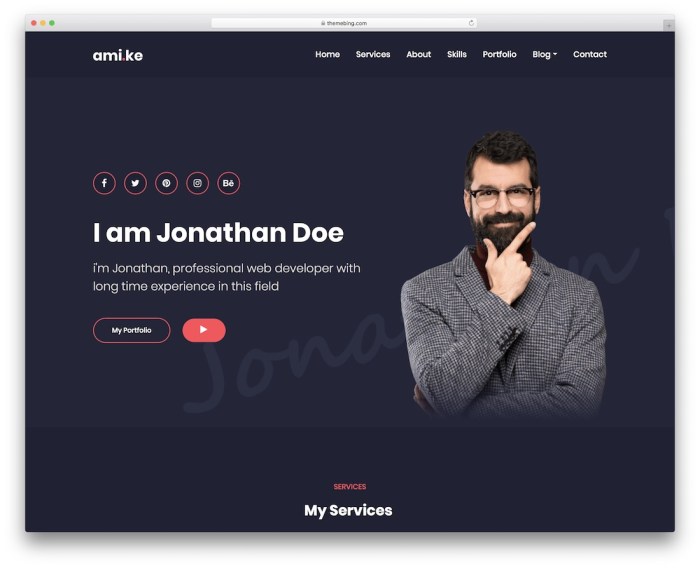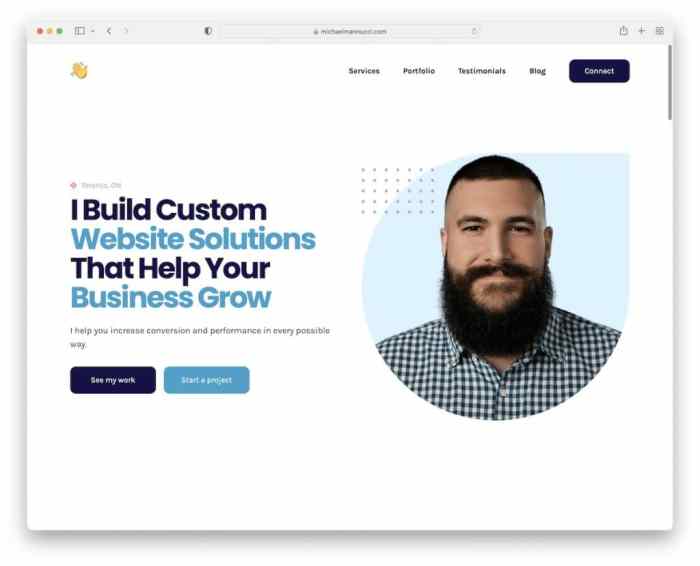Building a Personal Website opens up a world of possibilities to showcase your unique identity and skills in the digital realm. From defining your goals to selecting the perfect color schemes, this journey is all about crafting a virtual space that truly represents you.
Introduction to Personal Websites
Having a personal website can bring a multitude of benefits in today’s digital age. It serves as your online presence, allowing you to showcase your work, skills, and personality to a global audience.
The purpose of a personal website is to establish your brand, create a professional image, and stand out in a competitive market. It can also serve as a hub for your online activities, including blogging, portfolio display, and networking.
Examples of Popular Personal Websites
- Neil Patel – A renowned digital marketer who uses his personal website to share valuable insights, blog posts, and services.
- Marie Forleo – An entrepreneur and life coach who utilizes her website to offer online courses, resources, and inspiration.
- Gary Vaynerchuk – A business mogul and motivational speaker who leverages his site for content creation, podcasts, and personal branding.
Planning Your Personal Website
When it comes to building your personal website, planning is key to success. From defining your goals to choosing the right domain name, every step plays a crucial role in creating a website that truly reflects your personal brand.
Defining Your Goals and Target Audience
Before diving into the design and content of your website, take some time to define your goals. What do you want to achieve with your website? Are you looking to showcase your portfolio, share your expertise, or promote your services? Understanding your goals will help you create a website that serves its purpose effectively.As you define your goals, also consider your target audience.
Who are you trying to reach with your website? Understanding your audience’s needs and preferences will guide your content creation and design choices, ensuring that your website resonates with your visitors.
Choosing a Domain Name
Your domain name is a crucial part of your personal brand, so choose wisely. Opt for a domain name that reflects your personal brand and is easy to remember. Avoid using complex or confusing names that may be hard for visitors to recall.When selecting a domain name, consider using your name or a variation of it. This will not only make your website more personal but also help with branding.
Keep it simple, relevant, and memorable to make a lasting impression on your visitors.
Essential Pages to Include
When building your personal website, there are a few essential pages that you should include to provide a comprehensive overview of who you are and what you offer. These pages typically include:
- About Me: A brief introduction to who you are, your background, and your expertise.
- Portfolio: Showcase your work, projects, or accomplishments to demonstrate your skills.
- Contact: Make it easy for visitors to get in touch with you by including a contact form or your contact information.
- Blog: If you plan to share regular updates or insights, consider adding a blog section to engage with your audience.
By including these essential pages on your personal website, you can create a well-rounded online presence that effectively communicates your personal brand to your audience.
Design and Layout

When it comes to your personal website, design and layout are key players in making a great first impression on your visitors. A user-friendly design not only enhances the overall experience but also helps users navigate your site easily and find the information they are looking for quickly.
Importance of a User-Friendly Design
A user-friendly design ensures that your website is visually appealing, easy to navigate, and accessible across different devices. By organizing content effectively and using clear navigation menus, you can create a seamless browsing experience for your visitors.
- Keep your layout clean and organized to avoid overwhelming your visitors.
- Use intuitive navigation menus and buttons to help users find their way around your site.
- Optimize your website for mobile devices to reach a wider audience.
- Consider the loading speed of your site to prevent users from getting frustrated.
Website Builders and Platforms for Personal Websites
There are several website builders and platforms available that cater to individuals looking to create a personal website without the need for coding skills. Some popular options include:
- WordPress: Known for its flexibility and customization options, WordPress is a popular choice for personal websites.
- Squarespace: Ideal for those looking for a sleek and modern design, Squarespace offers easy-to-use templates.
Selecting Color Schemes and Fonts
Choosing the right color schemes and fonts for your personal website is crucial in reflecting your style and creating a cohesive look. Consider the following tips:
- Stick to a color palette that complements your personal brand or personality.
- Use high contrast colors for text and background to ensure readability.
- Select fonts that are easy to read and align with the tone of your content.
- Consistency is key – maintain the same color schemes and fonts throughout your website for a polished look.
Content Creation: Building A Personal Website
When it comes to creating content for your personal website, it’s essential to make sure it’s engaging, informative, and reflects your personality. Your content should be a true representation of who you are and what you’re passionate about. Here are some tips to help you create compelling content for your website.
Optimizing Content for Search Engines
To ensure your personal website gets noticed, it’s crucial to optimize your content for search engines. This involves using relevant s, meta tags, and descriptions that accurately reflect the content on your website. Additionally, creating high-quality, original content that provides value to your audience can help improve your website’s search engine rankings.
- Research relevant s and incorporate them naturally into your content.
- Write descriptive meta tags and page titles that accurately represent your content.
- Create high-quality, engaging content that is valuable to your audience.
- Regularly update and refresh your content to keep it relevant and current.
Integrating Multimedia Elements
Adding multimedia elements like images and videos to your personal website can make it more visually appealing and engaging for your visitors. These elements can help showcase your work, highlight your achievements, and provide a more interactive experience for users.
- Include high-quality images that reflect your brand and personality.
- Create videos to showcase your skills, projects, or personal experiences.
- Optimize images and videos for fast loading times to improve user experience.
- Ensure multimedia elements are relevant and add value to your content.
Functionality and Features

When building a personal website, it’s essential to consider the functionality and features that will enhance the user experience. From contact forms to social media integration, these elements can make your website more interactive and engaging for visitors. Mobile responsiveness is also crucial in today’s digital age, as more people access websites on their smartphones and tablets. Additionally, optimizing website speed and performance can help retain visitors and improve your site’s overall usability.
Contact Forms
Contact forms are a convenient way for visitors to reach out to you directly through your website. They provide a professional and organized means of communication, allowing users to inquire about your services or provide feedback easily.
- Include fields for name, email, and message to capture essential information from visitors.
- Utilize CAPTCHA or other spam prevention methods to ensure the security of your contact form.
- Regularly check and respond to messages received through the contact form to maintain timely communication with your audience.
Social Media Integration
Integrating social media into your personal website can help expand your online presence and reach a broader audience. By linking your website to your social media profiles, you can increase engagement and connect with visitors on different platforms.
- Display social media icons prominently on your website for easy access to your profiles.
- Share your website content on social media to drive traffic and encourage sharing among followers.
- Engage with your audience on social media by responding to comments and messages to build relationships and loyalty.
Mobile Responsiveness
With the increasing use of mobile devices, it’s crucial to ensure that your personal website is responsive and optimized for different screen sizes. A mobile-friendly design can enhance the user experience and make navigation easier for visitors accessing your site on smartphones or tablets.
- Use responsive design techniques to adapt your website layout to various screen sizes and orientations.
- Test your website on different mobile devices to ensure it displays correctly and functions smoothly.
- Optimize images and content for mobile viewing to improve load times and overall performance on smaller screens.
Optimizing Website Speed and Performance
A fast and well-performing website is essential for retaining visitors and improving search engine rankings. By optimizing your site for speed and performance, you can provide a seamless browsing experience for users and increase the likelihood of them returning to your website.
- Compress images and files to reduce load times and improve page speed.
- Minimize HTTP requests by combining CSS and JavaScript files and eliminating unnecessary elements.
- Enable browser caching and utilize content delivery networks (CDNs) to enhance website performance and responsiveness.
Personal Branding
Building a strong personal brand through your website is essential in showcasing your unique identity and standing out in a crowded digital space. It involves creating a consistent brand voice and image that resonates with your audience and effectively showcases your skills and achievements.
Creating a Consistent Brand Voice and Image, Building a Personal Website
To create a strong personal brand, it’s crucial to maintain a consistent voice and image across all aspects of your website. This includes using consistent language, tone, and visual elements that reflect your personality and values. By ensuring that every element of your website aligns with your brand identity, you can establish a memorable and cohesive online presence.
- Use the same tone and language throughout your website to create a cohesive brand voice.
- Choose a color palette, typography, and design elements that reflect your personality and style.
- Include a professional headshot and bio that communicates your expertise and values.
Showcasing Your Skills and Achievements Effectively
Effectively showcasing your skills and achievements on your website is key to building credibility and attracting opportunities. By highlighting your accomplishments in a clear and compelling way, you can demonstrate your expertise and value to potential collaborators, clients, or employers.
- Create a dedicated “Portfolio” or “Projects” section to showcase your work and accomplishments.
- Include testimonials or endorsements from clients or colleagues to build trust and credibility.
- Regularly update your website with new projects, achievements, or skills to demonstrate growth and expertise.
